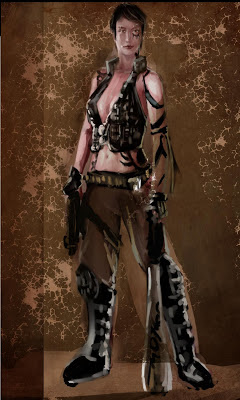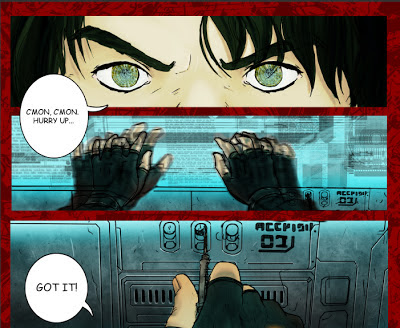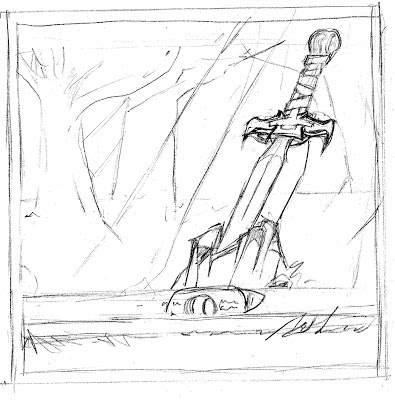 |
| Cityscape by Joseph Tai |
Last week's visit to Spectrum inspired me to write a bit about my own struggle as an artist or rather my misadventures to create a comic book series without the possession of any artistic abilities. The story starts in September 2004 with an idea. Being a fairly experienced storyteller at the time (running about 12 concurrent D&D games, writing 2 to 3 short stories a week) and almost a college freshman with a legal handwriting disability, I sat down and scrawled out an illegible spider-web of words that all connected to a central word in the middle of the page: "Twitch." This was the name of the character I had in mind. The other words were connecting points about the world I had in mind for the character, other characters, or ideas like: "post apocalyptic", "streets", "skorpion + baseball bat mix", "Grimm", "gangs", and "nocturnal." This was written midst the notes of a macroeconomics class and, like any good student, I promptly lost the paper and with it the idea.
 |
| My Original Sketch |
A few months later during the Christma- er,
Yuletide (I'm reading Krampus: Yule Lord at present) break I came across the page, which had almost entirely faded (Pro Tip: erasable ink erases on its own after awhile). I wrote more of my spider-web diagrams, expanding on various elements, making lists, and I finally drew a little sketch of the character with a map of the city in my head. I spent most of the winter break brainstorming parts of the setting but once school picked back up I lost track of what I'd worked on and couldn't find the pages because it was (again) all done between calculus or financial accounting notes. This pattern of discovery, expansion, loss, discovery, expansion, and loss continued every break from college I had, returning to me more vividly and dear to my heart each time I rediscovered it. I slowly added more characters, depth, and started to create a context for it all. Before getting distracted by college projects, by starting a band, by summer jobs, and by beloved video games I got a little bit further in developing the world until a story started to form. It started off as "betrayed gangers seek revenge" but quickly evolved into an extremely lengthy handwritten novel, mixed in with the occasional note from Advanced Statistics or Principles of Business Ethics.
 |
"Sit down and write an outline, dammit!" -Yuri
Unused Issue 2, Page 13 - by Joseph Tai... |
In 2007 I ran a few pen and paper games in the setting to try and see what other people thought of it and got generally positive feedback. Because (at the time) I had commitment issues in completing any writing project longer than 50 pages I recruited my friend Yuri to help me form a coherent outline. Though we weren't always on the same page, Yuri added much needed structure to my life and motivated me to sit down and complete a full outline of the story, which had previously been envisioned without a clear end in sight (sort of like a D&D game). Yuri also pushed the main character i'd designed the series around (Twitch) into more of a back-seat role. The story now focused on a witty male protagonist named Justice, whom Twitch followed like a silent guardian angel of death. As a feminist I was sad to make the change but since Twitch was a character that didn't talk much, and I was pretty uncompromising about her nature as a character, it was hard to argue her as the main character from a storytelling perspective.
 |
Crushing Defeat...
Early Sketch by Adam |
After graduating college I'd saved up just enough money to avoid joining the work force for three solid months and secluded myself from music, friends (except my trusty kitten, Evanrude), video games, and entertainment to write. I was a ghost. The only time I was seen in public was at a local Burger King, mapping out the dimensions so I could re-create a space of similar size in which to map out fight choreography. Since I was now looking to make the story into a film (I had some experience in the film industry so it seemed like a logical step), I wrote the first draft in a few weeks, revised it, put together a solid prospectus (a brochure to get investors), and spent the rest of the time seeking backers for the film (which needed about $3.4M if done to low-budget Hollywood standards). To my credit, I was able to sign backers for $1.27M (you read that right) of the budget through a process just shy of selling my soul to a few well-dressed businessmen in LA, but because I ultimately couldn't secure the other (huge) chunk of money I wasn't able to get the project off the ground. Defeated, I wallowed in self-pity for awhile and started a lawn care company. Luckily for my mental state, rumors for The Dark Knight were friendly distractions from my failure, because it's never advisable to do lawn care without good things to think about. That sort of what I envision as being the inner circle of hell. A giant push mower that doesn't start easily.
 |
| The Conway Brothers by Ryan W. |
When business started to slow down in the winter of '07/'08 I found myself with a lot of down time and kept thinking about what had gone wrong. All else aside I concluded that the story was solid, so, since I had a fairly steady income I thought it might be an interesting idea to just try and convert the script into a comic book. I'd already done the work on the writing end so what was the harm in giving the script to a talented artist? I quickly discovered just how difficult finding an artist I could afford was, and it took me a few months of searching until I finally discovered the art of Ryan W., a notoriously short-tempered but talented artist hailing from Canada I'd met through an internet forum. What harm could possibly come of sending someone on the internet money in exchange for services that would be rendered after payment?
 |
| A "Scan" of Twitch by Ryan W. |
A few weeks after sending him a down payment, Ryan informed me that after many attempts he discovered that he couldn't draw women unless they were wearing gas masks, a problem I hadn't really expected after looking through his Deviantart page. He also told me that after drawing the first two sketches he found that he wasn't interested in the characters I'd written, that he changed the entire script, drawn the first 7 pages of his version of the script, and that he had already spent my down payment. The "PS" included that I was able to use "these scans" of the images he sent me in any way I chose, as consolation, so here they are... Six months after not hearing anything from him, he eventually sent me a message from a public library apologizing and informing me that he'd lost everything after acquiring a hard drug addiction.
 |
| 2nd Revised Concept by Yuri's Friend |
Around the same time Yuri had suggested a friend of his (also in the lawn care industry, but who's name I can't remember) who went to art school. I gave him a clear description of the character I'd wanted him to draw (Twitch) along with a large (for me) sum of money, and about three weeks later I got a concept that had no resemblance to what I'd asked for. After a few weeks of revisions (going from sexy native american to less-sexy biker) he finally agreed creating something that loosely resembled what I was looking for, though significantly more sexualized. The whole experience left me feeling quite sour because even after he finished the art (and took payment) he would never formally sign anything to allow me to use the images to promote the comic. Shortly before giving up altogether I randomly met an extremely talented young artist named Joseph Tai who was both interest in the project and within my limited price range. It turns out that my "limited price range" was on the high end of the going professional rate at the time but, oblivious to the fact, I was just happy to support someone local who would create the images that matched my descriptions. Joe's art had style, he had an honest work ethic, and that's all I really cared about.
 |
| Issue "0", Page 16 - Joseph Tai |
The first issue of the fifteen part comic book series had taken Joe the better part of a year to complete (from start to finish), and while he was genuinely working his hardest I didn't think that any publishing company would accept a 16 page, yearly release comic. So, with the idea of working towards a quarterly release I limited his workload from "everything" to "sketch/ink/text/formatting" and hired the fantastically talented
Ean Moody to color a page a day. Joseph and I worked together on the comic in this way for two years (on and off with Ean as we still worked significantly slower than he did), completing roughly four comics in under two years with sketches for another issue well in progress. Then, suddenly and unexpectedly in the Florida winter of 2010 Joe left the gulf coast to seek gainful employment and ceased all involvement on the project.
 |
| Early Sketch by Adam |
Once again up the proverbial creek, I was done with artists, done with the story, and more emotionally exhausted than I'd been from all of the other setbacks combined. The worst part of it was that I could actually see the story progressing, had introduced the characters, and was well on my way through the series when it happened... So, mid 2011 I was completely surprised that while talking about my "failed project" during downtime at a recording session, my drummer-friend
Adam volunteered to sketch and ink the entire series. Adam had but one key condition in working with me: "that the series has to be awesome." That meant no plot holes, no references to modern culture, no comic sans, and no cutting corners. I'd admittedly cut a few corners earlier, compromised in places, but from this point onward I'd have to approach the project with my full professional effort. As the comic now signified a lot more than just something I'd written over seven years, I shook hands and committed to those terms. This was going to be my best work and my level of approach went from "work of passion/side-project" to "professional-grade".
 |
| Elevator Sketch by Adam |
We spent the next year simply developing the new art style, the world, the culture, and the characters. We didn't even work on comic pages, just experimented, going from pointillism to cross-hatching. We also gave the setting a lot of thought, developed a language, society, weapons, clothing, government, etc. Eventually, once he'd redrawn the first issue of the comic it was clear that I'd have to completely rewrite the script to fit the new darker setting. It also became apparent that because Adam had not taken formal art classes he could benefit strongly from having reference photos, so we hired talent and hosted a weekend-long photo shoot. The shoot immediately affected Adam's work, making things less stiff and shifting the style from slightly toonish to gritty.
 |
| Punk Concept #3 by Adam |
Over the last year, we upped our commitment to the series, by putting in part time hours on the project (no less than 20 hours a week) and haven't looked back since. To date we've completed story boards (we call them "Thumbs") for 10 issues, sketches for 6, and show no sign of slowing down. Because the "thumbs" aren't particularly pretty (basically pre-sketch lighting/character/location guides) I don't regularly post them or mention the comic much but it's what Adam and I have been up to for the last two years and will be up to for the foreseeable future.
.jpg) |
| Issue 10, Page 6 "Thumb" by Adam |





































.jpg)